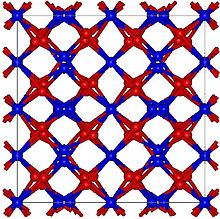Zinc nitride

| |
| Identifiers | |
|---|---|
3D model (
JSmol ) |
|
ECHA InfoCard
|
100.013.826 |
| EC Number |
|
PubChem CID
|
|
| UNII | |
CompTox Dashboard (EPA)
|
|
| |
| |
| Properties | |
| Zn3N2 | |
| Molar mass | 224.154 g/mol |
| Appearance | blue-gray cubic crystals[1] |
| Density | 6.22 g/cm3, solid[1] |
| Melting point | decomposes 700°C[1] |
| insoluble, reacts | |
| Structure | |
| Cubic, cI80 | |
| Ia-3, No. 206[2] | |
| Hazards | |
| GHS labelling: | |

| |
| Warning | |
| H315, H319 | |
| P264, P280, P302+P352, P305+P351+P338, P321, P332+P313, P337+P313, P362 | |
| NFPA 704 (fire diamond) | |
Except where otherwise noted, data are given for materials in their standard state (at 25 °C [77 °F], 100 kPa).
| |
Zinc nitride (Zn3N2) is an inorganic compound of zinc and nitrogen, usually obtained as (blue)grey crystals. It is a semiconductor. In pure form, it has the anti-bixbyite structure.
Chemical properties
Zinc nitride can be obtained by thermally decomposing zincamide (zinc diamine)[3] in an anaerobic environment, at temperatures in excess of 200 °C. The by-product of the reaction is ammonia.[4]
It can also be formed by heating zinc to 600
3
chemical vapour deposition of Bis(bis(trimethylsilyl)amido]zinc with ammonia gas onto silica or ZnO coated alumina at 275 to 410 °C.[8]The crystal structure is anti-
isomorphous with Manganese(III) oxide. (bixbyite).[2][7] The heat of formation is c. 24 kilocalories (100 kJ) per mol.[7] It is a semiconductor with a reported bandgap of c. 3.2eV,[9] however, a thin zinc nitride film prepared by electrolysis of molten salt mixture containing Li3N with a zinc electrode showed a band-gap of 1.01 eV.[10]Zinc nitride reacts violently with
Zn3N2 + 3
Zinc nitride reacts with lithium (produced in an electrochemical cell) by insertion. The initial reaction is the irreversible conversion into LiZn in a matrix of beta-Li3N. These products then can be converted reversibly and electrochemically into LiZnN and metallic Zn.[11][12]
See also
References
- ^ a b c d CRC Handbook of Chemistry and Physics (96 ed.), §4-100 Physical Constants of Inorganic Compounds
- ^ .
- ^
Roscoe, H. E.; Schorlemmer, C. (1907) [1878]. A Treatise on Chemistry: Volume II, The Metals (4th ed.). London: Macmillan. pp. 650–651. Retrieved 2007-11-01.- ^ a b Bloxam, C. L. (1903). Chemistry, Inorganic and Organic (9th ed.). Philadelphia: P. Blakiston's Son & Co. p. 380. Retrieved 2007-10-31.
- ^
Lowry, M. T. (1922). Inorganic Chemistry. Macmillan. p. 872. Retrieved 2007-11-01.- ^ a b Maxtead, E.B. (1921), Ammonia and the Nitrides, pp. 69–20
- ^ a b c Mellor, J.W. (1964), A Comprehensive Treatise on Inorganic and Theoretical Chemistry, vol. 8, Part 1, pp. 160–161
Further reading
- Futsuhara, M.; Yoshioka, K.; Takai, O. (1998). "Structural, electrical and optical properties of zinc nitride thin films prepared by reactive RF magnetron sputtering". Thin Solid Films. 322 (1): 274–281. .
- Lyutaya, M. D.; Bakuta, S. A. (1980). "Synthesis of the nitrides of Group II elements". Powder Metallurgy and Metal Ceramics. 19 (2): 118–122.
S2CID 93036462.- Wu, P.; Tiedje, T. (2016). "Molecular beam epitaxy growth and optical properties of single crystal Zn3N2 films".
S2CID 99713171.External links

